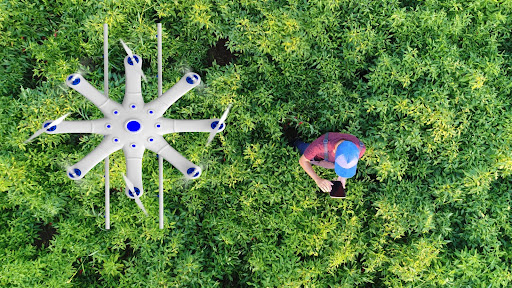As we journey through 2025, the race to leverage cloud computing, advanced analytics, and AI/ML grows ever more competitive. Organizations across healthcare, manufacturing, finance, and farming are uncovering new ways to accelerate their digital transformations. As a Google Cloud Solutions Architect working for a Google Cloud partner, I’ve had a front-row seat to the innovations shaping these industries. Here are my top five tech predictions for the year ahead—and how Google Cloud technologies will play a pivotal role in making them a reality.
1. Healthcare: From reactive care to predictive, data-driven insights
In 2025, healthcare organizations will continue to harness cloud-powered AI/ML to move from a reactive care model to a truly predictive one. This will lead to earlier disease detection, more personalized treatments, reduced costs, and help employers manage staff load to minimize churn.

- AI-enabled diagnostics: Healthcare providers will deploy AI models trained on large data sets of patient histories, imaging, and genomics to detect early signs of diseases like cancer or heart conditions. With Vertex AI, clinicians can build, train, and deploy custom models at scale, quickly turning research breakthroughs into bedside practice.
- Interoperability and secure data sharing: Patient data will flow securely across hospitals, clinics, and research institutions with the help of cloud-based integration services like Healthcare Data Engine on Google Cloud. By centralizing data in BigQuery, healthcare organizations can ensure real-time access to patient insights while maintaining HIPAA compliance. apree health, a leading healthcare platform and SADA customer, faced this very challenge. Their rapid growth led to a complex web of on-premises systems, hindering data flow and compromising security. By migrating to Google Cloud and leveraging services like BigQuery, they were able to centralize their data, improve access to patient insights, and strengthen their security posture while maintaining HIPAA compliance. This demonstrates how cloud-based integration services are essential for achieving true interoperability in healthcare.
Similarly, Redox, a leading provider of healthcare data interoperability solutions, recognized the need for a multicloud strategy to leverage the strengths of both AWS and Google Cloud. However, managing different environments and ensuring consistent security and compliance across platforms presented a significant challenge. Partnering with SADA, they were able to design a cloud-agnostic infrastructure, streamline deployments, and enhance security measures, ultimately preventing client churn, securing major contracts, and accelerating product development.

- Telehealth and remote care: As telemedicine continues to expand, solutions built on Google Cloud’s global network will deliver seamless, secure video consultations and remote monitoring, bringing critical care to underserved areas. Cloud-based API services and advanced networking capabilities reduce latency, providing real-time and high-quality video streams.
- Medical research and genomics at scale: Researchers will accelerate discoveries by running large-scale genomics workloads on secure, scalable infrastructure. Cloud HPC (High-Performance Computing) and Google Kubernetes Engine (GKE) can spin up massive compute clusters to process and analyze genomic data faster and more cost-effectively than ever. This scalability is crucial for institutions like the Bloorview Research Institute (BRI), Canada’s largest pediatric rehabilitation and continuing care teaching hospital. BRI’s aging on-premises infrastructure was hindering their ability to process data quickly, impacting research timelines. Partnering with SADA and leveraging Google Cloud, they migrated 15TB of data, enabling them to run compute-intensive research more efficiently and cost-effectively, freeing them from the limitations of their older hardware.
2. Manufacturing: Intelligent factories and autonomous operations
Another sector that will see major change is manufacturing. Manufacturers will embrace advanced automation powered by AI/ML and real-time analytics, creating self-optimizing factories that predict maintenance needs, reduce downtime, and keep up with ever-changing market demands.
- Predictive maintenance with IoT: Data collected from IoT sensors on machinery will be processed at the edge or in the cloud using Google GDC (or Cloud Pub/Sub for real-time data ingestion). AI models will predict failures before they happen, reducing downtime and extending the life of equipment.
- Digital twins for process optimization: Manufacturers will create digital twins—virtual replicas of physical assets—on Google Cloud. By simulating production lines or entire facilities, they can test changes, forecast performance, and optimize workflows in a risk-free environment. Nvidia recently demoed this via its Physical AI model.
- Secure, scalable infrastructure: Security is paramount as plants and supply chains become increasingly interconnected. Leveraging Google Cloud’s security solutions—including data encryption, secure identities with Identity and Access Management (IAM), and threat detection with Google Security Operations Suite—will protect networks, edge devices, and intellectual property from rapidly evolving cyber threats.

- Industrial robotics and computer vision: Factory robots can identify product defects or anomalies in real time using computer vision models built on Vertex AI, which significantly improves quality assurance, lowers waste, and accelerates production schedules.
3. Finance: Real-time fraud detection and hyper-personalized services
In 2025, financial institutions will leverage the next wave of AI/ML, big data analytics, and cloud-native architectures to deliver proactive fraud detection, real-time risk assessments, and deeply personalized financial experiences for customers.
- Proactive fraud detection: Fraud attempts become more sophisticated every day. Financial organizations will rely on streaming analytics with Pub/Sub and Dataflow and machine learning models in Vertex AI to detect anomalies in near real-time and block suspicious activity before it impacts consumers.
- Hyper-personalization with advanced analytics: Banks and fintechs will analyze customer data in BigQuery, deploying AI/ML models to deliver personalized offers, portfolio recommendations, and real-time financial guidance. Financial institutions will gain a decisive competitive edge by focusing on customer-centric innovation.

- Accelerated digital transformation: Many financial services organizations are modernizing core applications with containerization on Google Kubernetes Engine. Infrastructure modernization ensures agility, scalability, and resiliency, especially in times of volatile market demands.
- Compliance and governance at scale: Privacy, governance, and regulatory compliance remain critical. Tools like Cloud Data Loss Prevention (Cloud DLP) and Access Transparency help organizations maintain strict data control, meet data residency requirements, and confidently adopt cloud solutions without compromising on security or compliance.
From enhancing fraud detection to modernizing the employee experience, financial institutions are embracing the cloud to stay competitive. Companies like Questrade Financial Group are leading the way, demonstrating the value of a modern, cloud-based approach to collaboration and communication
4. Farming: Precision agriculture and sustainable food production
To meet the demands of a growing global population, agriculture is turning to cloud-based data analytics, IoT devices, and AI/ML to boost crop production while minimizing resource use and environmental footprint.

- Real-time crop monitoring: By deploying drones and sensors, farmers can access real-time insights into their crops and soil. This data, streamed into Google Cloud and analyzed by Vertex AI models, enables precise adjustments to irrigation, fertilization, and pest control, leading to improved yields and resource efficiency. Companies like DroneDeploy, a SADA customer, are leading the way in providing drone software solutions that enable farmers to efficiently collect and analyze this crucial data. Their platform not only facilitates drone flights but also processes and analyze
- IoT and edge analytics: Low-latency edge computing solutions on Google Distributed Cloud will allow farmers to process sensor data locally. This is especially critical in rural areas with limited connectivity, ensuring real-time insights into where and when farmers need them most.
- Forecasting and supply chain optimization: Efficiently getting crops from farm to table is crucial. BigQuery’s weather and market forecasting models, combined with supply chain integration, enable farmers to optimize planting and harvesting for peak yields and market prices, minimizing waste and maximizing profitability.
- Sustainability and resource efficiency: Climate change is putting immense pressure on agriculture. AI models built on Google Cloud offer a solution, guiding farmers toward reduced water consumption, optimized fertilizer use, and more sustainable practices—all vital for feeding the world’s expanding population. DroneDeploy’s story exemplifies how cloud technology is empowering precision agriculture and sustainable food production. By providing farmers with real-time insights, advanced analytics, and efficient data management, DroneDeploy is helping them optimize crop yields, reduce resource consumption, and make more informed decisions about their farming practices.
5. Security and compliance everywhere: The foundation of digital transformation
Cybersecurity will be fully embedded into every aspect of cloud solutions, ensuring that data and workloads are protected end-to-end, no matter the industry or location.

- Zero trust security models: Organizations will adopt a zero trust architecture, treating every internal or external connection as untrusted. BeyondCorp Enterprise from Google Cloud enables secure application access from anywhere, on virtually any device, reducing the risk of breaches.
- Comprehensive threat intelligence: With Google Cloud’s Chronicle, security teams will have the power of Google-scale data analytics to detect and respond to threats faster than ever. Chronicle’s real-time threat intelligence allows for proactive defense rather than a reactive scramble after breaches occur.
- Shared responsibility for compliance: From healthcare’s HIPAA regulations to finance’s PCI DSS, compliance requirements continue to expand. Google Cloud’s robust compliance offerings provide automated tools, continuous monitoring, and verifiable audit trails to help meet evolving standards across global jurisdictions.
- Automated remediation with ML: As threats grow in complexity, manual approaches to incident response become unmanageable. By harnessing machine learning, security teams can automate responses to common threats, allowing human analysts to focus on strategic tasks and complex incidents.
- Hardening Web Browsers: The increasing sophistication of browser-based attacks poses a significant risk to enterprises. Chrome Enterprise Premium provides a comprehensive security solution, protecting sensitive data and mitigating threats including sophisticated attacks, insider threats, web-based exploits, data exfiltration, and the complexities of hybrid work and BYOD environments.

The next few years will see remarkable transformations across healthcare, manufacturing, finance, and farming, driven by strategic cloud adoption, infrastructure modernization, and AI/ML at scale. Google Cloud is at the forefront of this shift—providing secure, scalable, and innovative technologies to help organizations achieve their boldest digital ambitions.
Whether you are a hospital aiming to detect diseases earlier, a manufacturer planning to optimize assembly lines, a bank mitigating real-time fraud, or a farm making every drop of water count, the future is in the cloud. By embracing these shifts now, organizations will be better positioned not only to survive but to thrive in 2025 and beyond.
Ready to prepare your business for the future?
Get insights into AI’s transformative power by downloading the AI Business Trends 2025 guide and learn how to protect your organization from evolving cyber threats in the Cybersecurity Forecast 2025. And when you’re ready to translate these insights into real-world results, SADA’s team of cloud experts can help you develop and implement a tailored strategy to achieve your business goals. Let’s talk.



